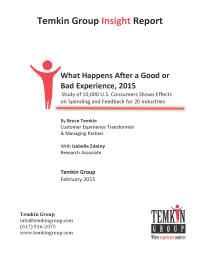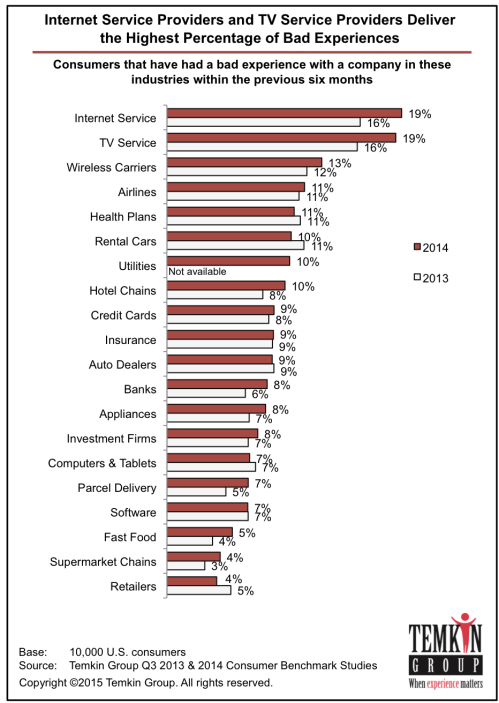Report: What Happens After a Good or Bad Experience, 2015
February 25, 2015 Leave a comment
 We just published a Temkin Group report, What Happens After a Good or Bad Experience, 2015. This is our annual analysis of which companies deliver the most and least bad experiences, how consumers respond after those experience (in terms of sharing those experiences and changing their purchase behaviors), and the effect of service recovery (see last year’s report).
We just published a Temkin Group report, What Happens After a Good or Bad Experience, 2015. This is our annual analysis of which companies deliver the most and least bad experiences, how consumers respond after those experience (in terms of sharing those experiences and changing their purchase behaviors), and the effect of service recovery (see last year’s report).
Here’s the executive summary:
To understand the effect of good and bad experiences, we asked 10,000 U.S. consumers about their recent interactions with 283 companies across 20 industries. Internet service providers and TV service providers deliver bad experiences more frequently than any other industries, as exemplified by Comcast and Charter Communications, each of which delivers a bad experience to about one in four customers, the most of any companies. Retailers, on the other hand, are least likely to deliver a negative experience. Out of all the industries, customers are most likely to stop spending completely after a bad experience with a computer and tablet maker, and they are most likely to reduce spending after a bad experience with a fast food chain. The economics of service recovery are compelling. Compared with companies that deliver a very poor response after a bad experience, companies that deliver a very good response have 41% fewer consumers cutting back on their spending and 31% more increasing their spending. Led by investment firms and major appliance makers, all industries improved or maintained their service recovery performance from last year. After a very bad or very good experience, consumers are more likely to give feedback back directly to the company than they are to post on Facebook, Twitter, or third party rating sites. These social sites, however, are still an important channel for consumers under the age of 45. When it comes to sharing bad experiences on social media, customers of Advantage Rent A Car and Alabama Power Company are the most likely to post about it on Facebook, while customers of Ameren Missouri Company and Fujitsu are the most likely to post about it on Twitter. The companies most likely to receive negatively biased feedback from their customers are Consolidated Edison of NY and Southern California Edison.
Here’s the first figure in the report:
Here are some highlights from the report:
- Nineteen percent of consumers who have interacted with TV service providers and Internet service providers report having a bad experience during the previous six months, the highest levels of any industry. Comcast (25%) and Charter Communications (24%) have the highest levels of consumers reporting bad experiences. The next three companies on the list are Motel 6, Time Warner Cable, and 21st Century insurance (all at 23%).
- At the other end of the spectrum, only 4% of consumers report having a bad experience with a retailer, and six retailers are at 1%: True Value, Costco, Bed Bath & Beyond, Ace Hardware, Gap, and Staples.
- The research examines the impact of bad experiences on consumer spending. Fifty-seven percent of consumers who had a bad experience with a fast food chain have decreased their spending with those stores and 32% of consumers who have had a bad experience with a computer company have completely stopped spending with the company. When it comes to health plans and utilities, two industries where consumers have a hard time switching, only 22% of consumers lower their spending after a bad experience.
- The research shows that companies can increase their revenues when they respond very effectively after a bad experience. The difference in spending between a consumer who experiences a very poor response by a company and one who experiences a very good response is dramatic; the better response leads to 41% fewer consumers decreasing their spending with the company and 31% more increasing their spending.
- The highest percent of consumers say that investment firms (48%) and major appliance makers (45%) have delivered a good response after a bad experience, while less than 20% of consumers feel that way about TV service providers and Internet service providers.
- While 32% of consumers told the company about a very bad experience, only 25% shared their very good experiences. The percentage of consumers who communicated after a good experience increased for every channel except telling friends via traditional channels, which stayed even this year.
- Across all age groups, consumers are most likely to give feedback about bad experiences directly to companies. With good experiences, the same is true with consumers who are at least 45 years old.
- We examined how many customers of each company had shared negative feedback (to any company) on Facebook over the previous six months. At the top of the list are Advantage Rent A Car, Alabama Power Company, Ameren Illinois Company, AirTram Airways, Audi dealers, Fujitsu, Ameren Missouri Company, and CellularOne.
The bottom line: Bad experiences are a real problem, especially if you don’t recover well.
